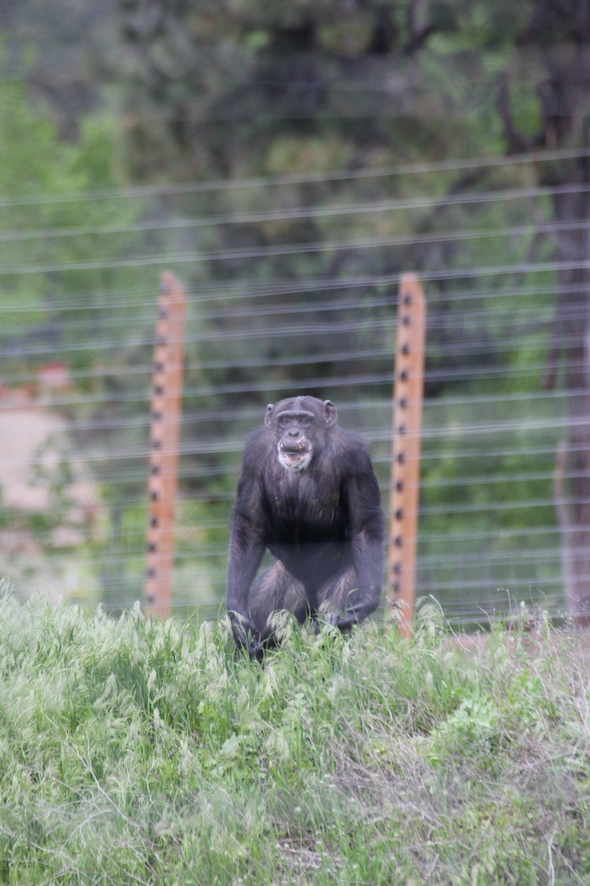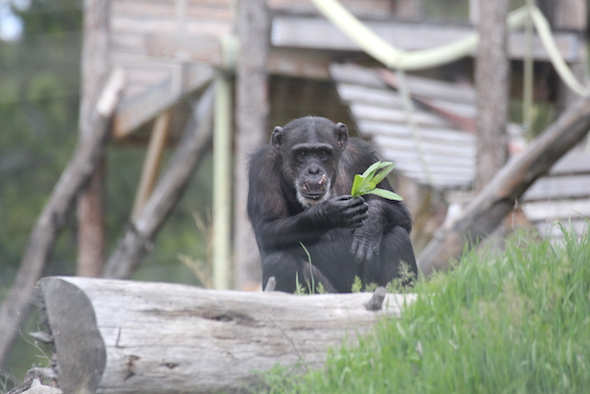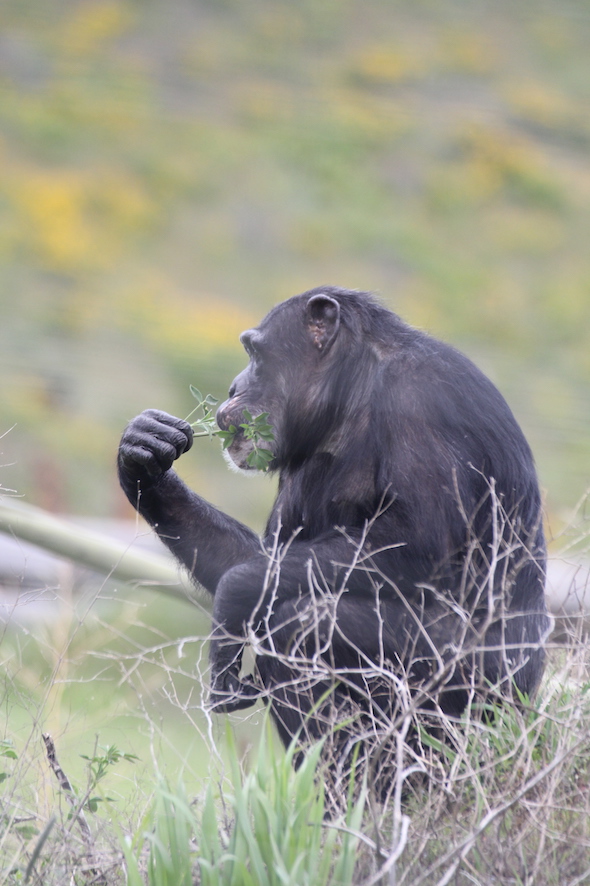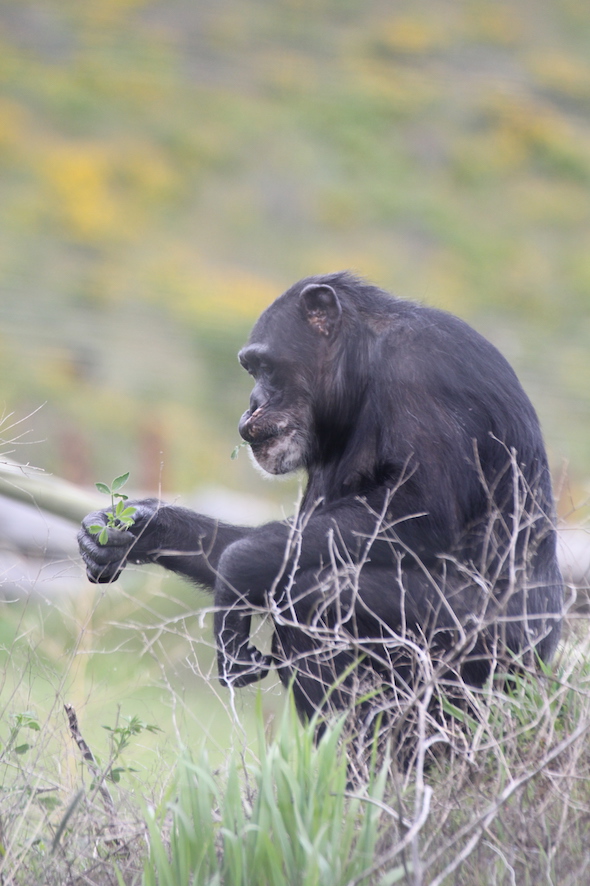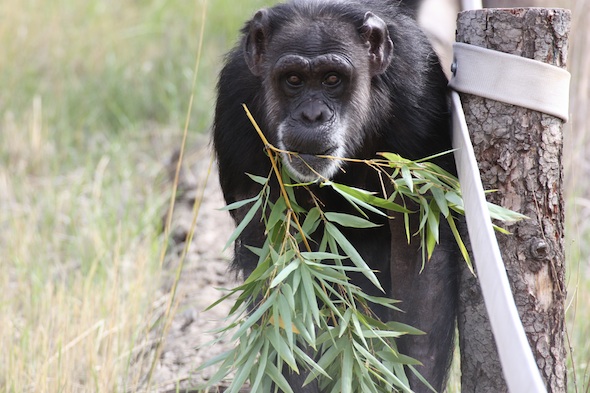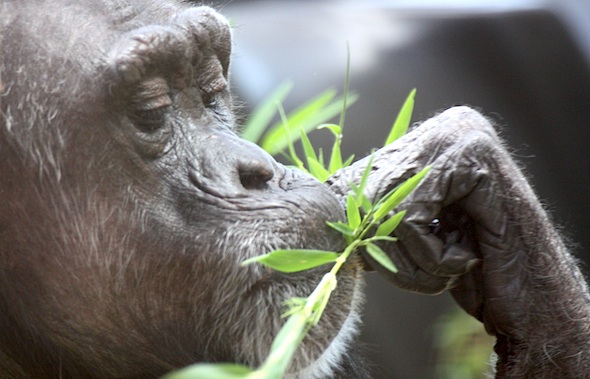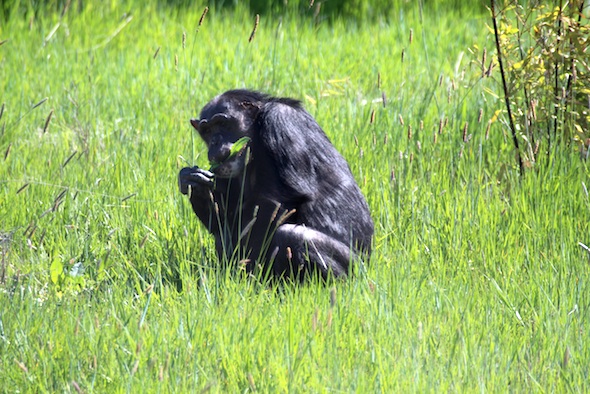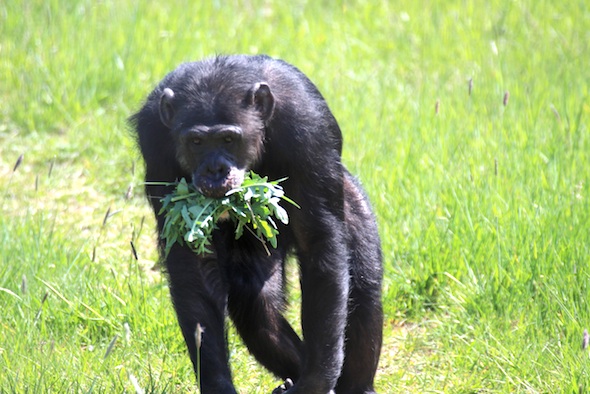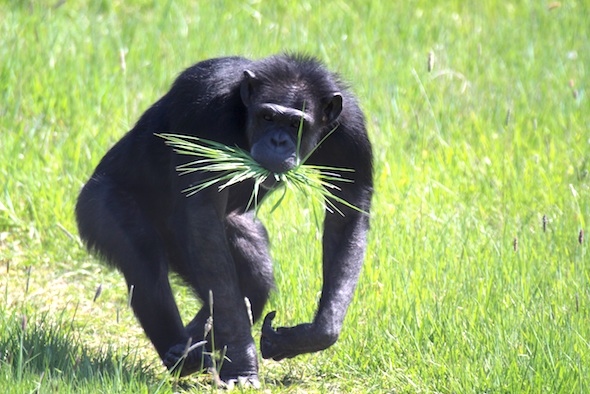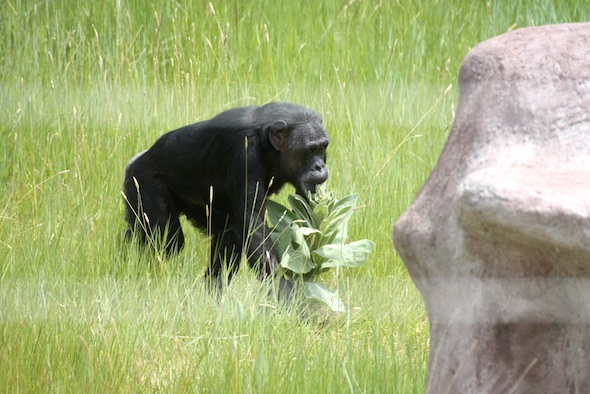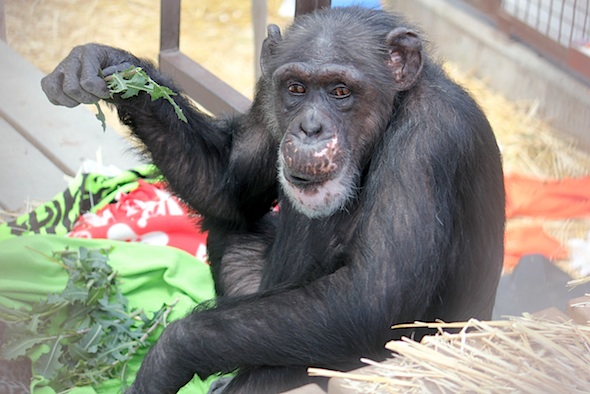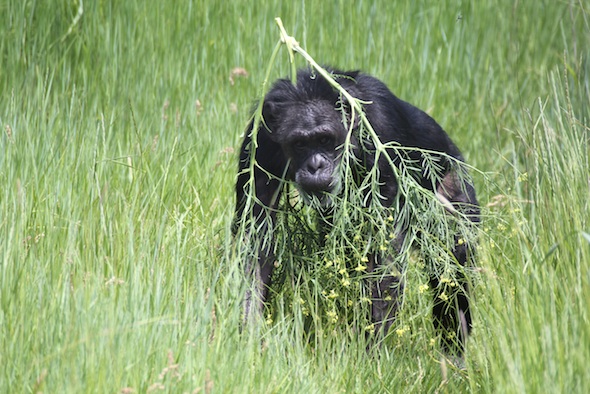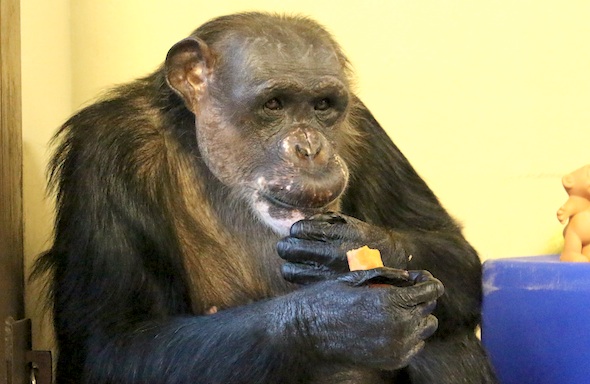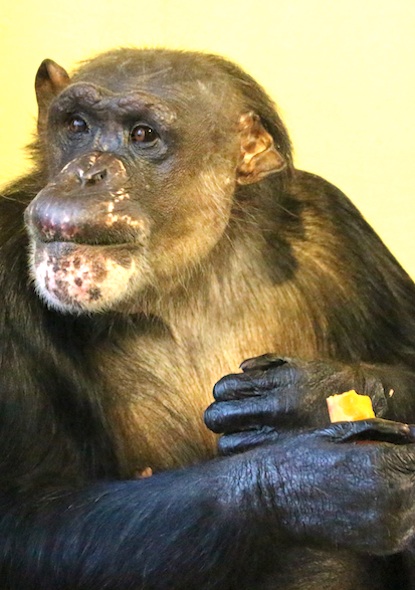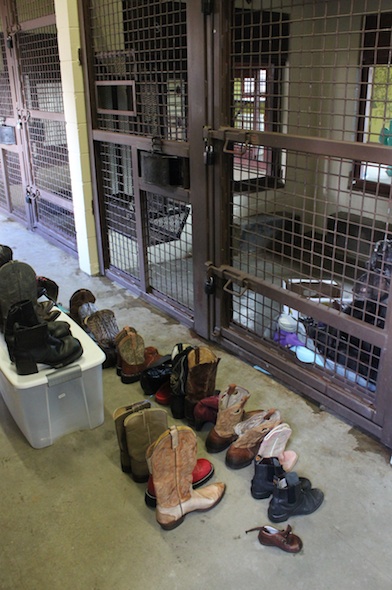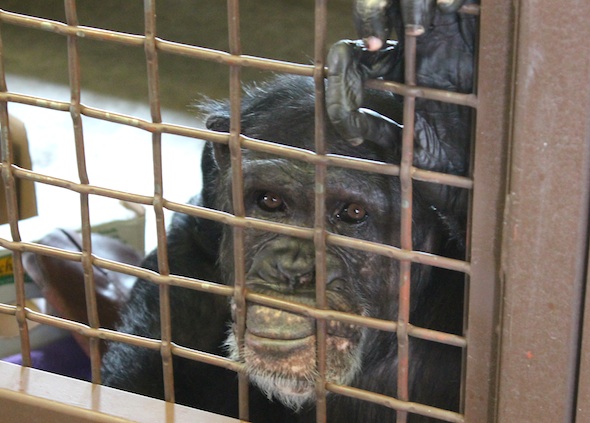As Sofía mentioned last month, we were hesitant to give the newly formed group of chimpanzees their smallest enclosure back. Now that Front Room 7 is back in action, we often find multiple chimpanzees choosing to gather in this space for social and relaxation sessions. We can often hear laughter echoing down the hallway from this room as we write the blog! When designing a sanctuary, you just never quite know where the popular “club houses” will be. I guess it just highlights the importance of following the chimps’ lead and letting them have as much choice in the matter as possible.
choice
Missy making choices
Last night, Dr. Steve Ross from Lincoln Park Zoo spoke at nearby Central Washington University. He was invited by the Primate Awareness Network, which is a CWU student organization affiliated with the Primate Behavior and Ecology (PBE) program.
This is a really unique program, so I’m going to take a moment to give it some advertising. It’s the only program that I’m aware of in the country that offers an undergraduate degree in Primate Behavior. A master’s degree is also offered, and now there’s yet a third option for those who are seeking formal education in primate care – a certificate program that provides students with all skills and experiences listed by the International Primatological Society for Animal Technician, and some skills and experiences listed for Senior Animal Technician.
All of the staff who work at Chimpanzee Sanctuary Northwest have been trained at some level at CWU. J.B. and I met there when we were enrolled in the graduate level program many, many years ago when there were still chimpanzees on campus (the last of the group of five chimpanzees who were part of the Chimpanzee and Human Communication Institute at CWU, Tatu and Loulis, now live with other chimpanzees at the Fauna Foundation, Canada’s only chimpanzee sanctuary).
Our sanctuary now works closely with the PBE program, offering intern credit for students who volunteer at the sanctuary. This gives students an opportunity to gain hands-on experience caring for primates while learning about their behavior. J.B. is an adjunct professor within the anthropology department and teaches a course on primate care.
Dr. Ross’s talk last night was about applied animal welfare, in other words, using behavioral research and data collection to gain information about primates that can be directly used to inform captive management decisions to improve individual welfare.
Dr. Ross stressed the importance of recognizing individual differences and letting the individuals tell you what they need and want based on their behavior.
And that brings me to my very informal observation of one of the individuals at CSNW today: Missy
As Jamie and Burrito were leading me on a walk around the 2-acre hill enclosure (me on the outside of the electric fence, of course), and Negra was taking a nap in the very warm greenhouse, Missy was out and about on her own mission to find and eat wild plants. She traversed across the hill, stopping occasionally to sample a bit of greenery.
It might be said that Missy has a bit more “wild and free” in her than some of the other chimpanzees. She is comfortable exploring on her own within the landscape of her little piece of nature, while some of the other chimpanzees seem to prefer to the company of others, or, like Negra, choose to venture out only when they are motivated to find a very particular plant during a very particular season.
Choice. This, above all else, is what increases primate welfare the most. When you think about it, much of what we share on the blog are the choices that the chimpanzees are freely making on a daily basis.
All you can eat
Chimpanzees seem to have a pretty good sense of time. Even if we haven’t started preparing dinner yet, the chimps at CSNW begin to gather near the window to the kitchen around 4 o’clock. They want to see what’s on the menu and remind us to hurry things along. But every once and a while, it remains ghostly quiet as dinner time nears – no one blowing raspberries at us, banging on the caging, clapping their hands, or stomping their feet. When this happens, it usually means one thing: They’ve started on dinner without us.
Chimps in captivity rely on humans for so much. Those who were wild caught, like Negra and Annie, were torn from their families, deprived of their native cultures, and forced into complete dependence on humans. And in some ways, they were the lucky ones, because those born into captivity never even got to experience a moment of independence in their lives. So when they learn to take back a tiny bit of autonomy, as they do when they choose when and what they’d like to eat, it is cause for celebration. And with two acres and a greenhouse full of bamboo and native plants, the chimps are able to make these choices every day.
Eating plants is good for their health, too. Chimps in the wild eat large quantities of rough fiber in the form of shoots, stems, and leaves. And while I don’t think we know yet exactly what role all of these foods play in their diet, we do know that this type if roughage allows captive chimps to snack all they want without putting them at risk for diet-related illnesses like heart disease and diabetes.
There are currently seven species of bamboo growing on Young’s Hill, and the chimps harvest from them year-round. Surprisingly, the bamboo on the hill seems to be prized most for its leaves, and the chimps tend to leave the fragile (but I would imagine tasty) shoots alone.
A few other species of bamboo that are more sensitive to Cle Elum’s chilly winters do very well in the chimps’ greenhouse enclosure, and send up their tender shoots (Chusquea gigantea shoots seems to be a delicacy) as early as March.
But in May, all of Young’s Hill becomes an all-you-can-eat salad bar. Even Negra will sit outside to snack on fresh dandelion greens.
Missy, always on the move, takes hers to go.
Spring grass is a favorite of nearly all the chimps. Annie collects only the best blades to bring back to the greenhouse.
In mid-summer, some larger plants begin to grow. Most people would consider them weeds, but the chimps think otherwise. Jody likes mullein, which I imagine to be the equivalent of eating bitter craft felt, but Jody must have a more refined palette.
Missy and a few others like prickly lettuce, which we mistook for dandelions for a while until we picked up some of their leftovers – they are just as prickly as the name suggests. Just like in the wild, captive chimpanzees will sometimes eat foods that are physically difficult to ingest. While many of the plants consumed by wild chimps have been shown to have medicinal value, such as the anti-parasitical Aspilia leaves, we don’t know if captive chimps are attempting to self medicate or are just eating adventurously.
The bane of my existence is this wild mustard. It grows so big and tough that it will break your weed eater. But when it grows inside the chimps’ enclosure, it gets taken care of by nature’s weed eater, otherwise known as Jody.
The chimps could never live on these plants alone, even if they do supplement with the occasional live frog like Negra does. But they are important in other ways. Like tonight, when the chimps all disappeared onto the hill just before dinner, you could almost hear them saying:
To heck with the humans, let’s eat!
Are Chimpanzees Picky Eaters?
People are often curious what foods the chimps like. The Cle Elum Seven as a group are not very picky – not nearly as picky as other chimpanzees I’ve known. The bulk of the food we provide for the chimps is raw (or sometimes baked or otherwise cooked) fresh produce, and almost everyone eats almost everything we serve. There are a couple of exceptions, of course.
Jamie, for example, eats almost everything, but really does not appreciate the skin of carrots, so we peel hers for her. She also will often turn up her nose if there’s raw spinach in the chimps’ morning smoothie, though I discovered the other day that cooked spinach (frozen and then thawed and blended up with some fruit and almond milk) is better than okay in her opinion. Foxie is probably the pickiest, and declines several different vegetables, preferring fruit. Surprisingly, she loves smoothie with either raw or cooked spinach, even though it’s doubtful she would eat spinach on its own.
Strangely (or maybe not so strange for those who agree with their tastes), as a group they don’t seem to care much for zucchini or summer squash, but they love pumpkin and they like spaghetti squash, so we’re always asking each other – do you know if they will eat this squash? This is what happened tonight when Elizabeth and volunteer Tania were getting dinner together. Elizabeth held up a butternut squash and asked if I knew if the chimps liked that variety. I really wasn’t 100% positive, but Negra gave us the answer with her food squeaks:
It turns out they all loved it. Missy was probably the most excited, but was moving far too fast to get photos. We’ve learned it is always best to give things a try, even if there’s a chance that one of the chimps might not like one of the foods we serve. Sometimes tastes change, and, because we provide as large a variety of produce as possible and always have three or more choices in a given meal, there’s always something for everyone.
rule #1 – make your boss happy
We talk a lot about how Jamie is the boss not only of the Cle Elum Seven chimpanzees, but of the humans at the sanctuary too. People ask us what makes her the boss. I don’t know that I’ve ever explained it quite this way before, but I’d say a good 75% of the “why” behind Jamie’s leadership status is that she just knows she should be in charge. I don’t think there’s any question in her mind that she should have a privileged status among all of us.
This entitlement means that Jamie can be demanding. If she’s trying to get our attention in order for us to give her something, she’ll often stand in the loft of the playroom, look into the kitchen and stomp her feet or hit the caging. Today she did this after lunch. Volunteer caregiver Connie and I were the only humans in the building at the time. Connie did her best to try to figure out what Jamie wanted, bringing her out various favorite things like crayons, big container,s and a couple of pairs of boots.
But the boss was not satisfied.
So, we decided to get ALL of Jamie’s boots (even the extras that were in storage) and line them up outside of the front rooms. It’s something that I had tried over a year ago that worked (see that blog post), and we were out of options. I don’t know if this is exactly what Jamie wanted, but she was definitely pleased with our solution. She would point to certain boots and we would hold them up for her. Some of them she seemed to just want to look at, some she wanted to touch, and others she asked us to give her by standing near the chute with her hand in the position to grab a boot that we dropped in (you can see the rectangular hole and the wire mesh chute below in this photo).

